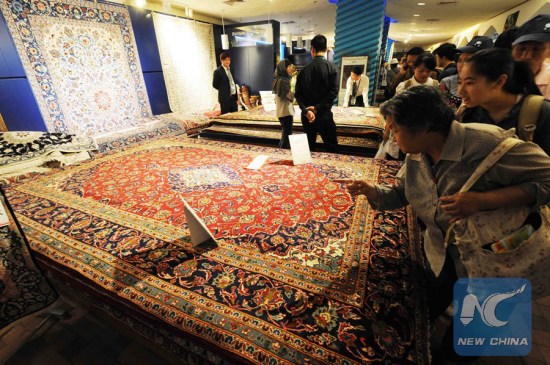
Tourists look at Persian carpets at the Iran Pavilion of the 2010 World Expo in Shanghai. (Photo: Xinhua/Wang Jianwei)
In Iran, the small northern town of Ardebil may not have the allure of top tourist attractions like Isfahan or Shiraz, but year after year culture-sensitive visitors still flock there to see a famed collection of ancient Chinese blue-and-white porcelain.
Displayed at the mausoleum of Sheikh Safi-din, a world cultural heritage site, the dozens of porcelain pieces dating back to the 13th century, always mesmerize visitors with the beauty of plants and animals vividly painted in blue against white china.
"All these treasures came from ancient China," a local tour guide known as Fardin repeats these words cheerfully every day as he shows visitors around the place.
"When I was small, it was something to be proud of to have a piece of genuine Chinese porcelain in one's home."
But what Fardin might not know is that these porcelain pieces were actually the joint work of ancient Iran and China that sat on the two ends of the thriving old Silk Road, as new research found that the blue paint applied on the wares was probably imported from Persia to ancient China, giving the objects a distinct look that Chinese workshops never successfully duplicated at the time.
According to Persian annals, part of the Chinese porcelain collection at the mausoleum was imported from China via the Silk Road, while other pieces were gifts to Persian dignitaries from Chinese emperors.
"Bestowing such valuable gifts on us shows that China and Iran have long been friends," Fardin said, noting such exchanges enriched both the Chinese and Persian cultures.
SILK ROAD LEGACY LIVES ON
The legacy of Silk Road route remains alive with Iranian businessmen.
Like his ancestors, Hussein Hosseiny travels regularly to China to sell Persian carpets, but the difference is he doesn't have to literally trek down the Silk Road.
For him, the centuries-old route is still as vibrant and profitable as before, as prized Persian silk carpets never fail to satisfy Chinese customers generation after generation.
Sadeq Zibakalam, a professor at the Tehran University, said everybody in Iran knows about the Silk Road and that ancient Persia and China were two hubs of the trade route.


















































